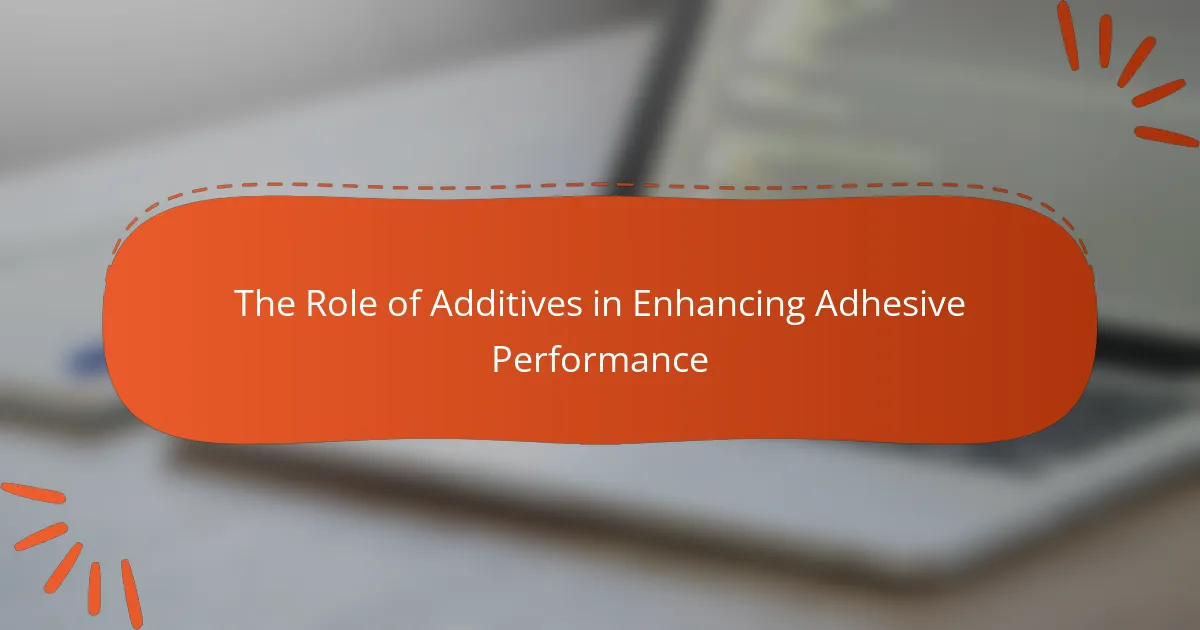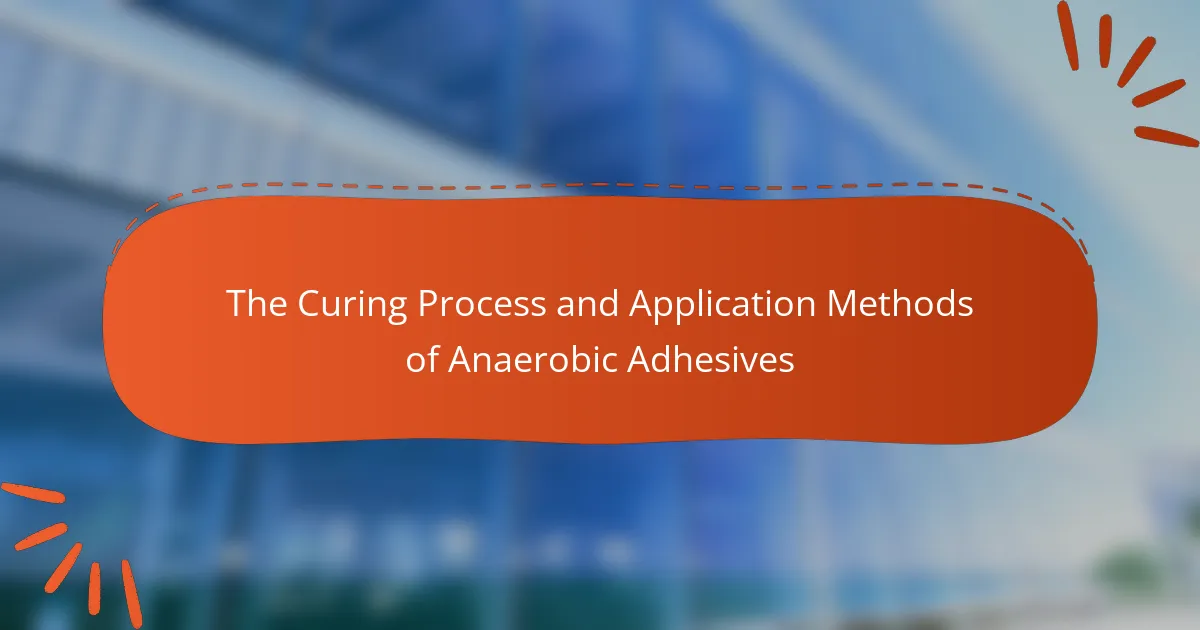Additives are substances incorporated into adhesives to enhance their properties, improving performance characteristics such as adhesion, flexibility, and curing speed. Key types of additives include plasticizers, which increase flexibility; fillers, which enhance strength and reduce costs; and curing agents, which accelerate the curing process. The effectiveness of these additives is influenced by factors like chemical compatibility, concentration, temperature, and the type of substrate being bonded. Additionally, the intended application of the adhesive dictates which additives are most beneficial, ensuring optimal performance in various environments.

What are Additives and Their Role in Adhesives?
Additives are substances added to adhesives to enhance their properties. They improve performance characteristics such as adhesion, flexibility, and curing speed. Common additives include plasticizers, which increase flexibility. Fillers can enhance strength and reduce costs. Stabilizers prevent degradation from heat or light. Each additive serves a specific function to optimize the adhesive for particular applications. For example, using a plasticizer can improve an adhesive’s ability to bond under stress. Studies show that the right combination of additives can significantly improve adhesive performance in various environments.
How do additives enhance adhesive performance?
Additives enhance adhesive performance by improving properties such as adhesion strength, flexibility, and curing speed. They can modify the viscosity of adhesives, making them easier to apply. Certain additives increase resistance to environmental factors like moisture and temperature. Others enhance the overall durability and longevity of the adhesive bond. For instance, plasticizers can improve flexibility, while fillers can enhance structural integrity. Research shows that specific additives can significantly reduce curing time, which increases efficiency in manufacturing processes. The incorporation of these additives leads to tailored adhesive formulations that meet diverse application needs.
What types of additives are commonly used in adhesives?
Common types of additives used in adhesives include fillers, plasticizers, and curing agents. Fillers enhance the viscosity and mechanical properties of adhesives. Plasticizers improve flexibility and reduce brittleness in the final product. Curing agents facilitate the hardening process of adhesives. Stabilizers are also used to increase the shelf life of adhesive formulations. Additionally, surfactants can improve adhesion and wetting properties. Each of these additives plays a crucial role in enhancing adhesive performance for various applications.
How do different additives affect adhesive properties?
Different additives significantly influence adhesive properties. They can enhance adhesion strength, improve flexibility, and alter curing times. For example, plasticizers increase flexibility and reduce brittleness in adhesives. Fillers can enhance viscosity and reduce costs while maintaining performance. Tackifiers improve initial adhesion, making the adhesive stickier upon application. Surfactants can enhance wetting properties, allowing adhesives to spread more easily on surfaces. Each additive’s effect varies based on its chemical composition and the adhesive system used. Studies show that optimizing additive combinations can lead to improved performance metrics, such as tensile strength and shear resistance.
Why are additives important in adhesive formulations?
Additives are important in adhesive formulations because they enhance performance characteristics. They can improve adhesion, flexibility, and durability of adhesives. Additives also modify the curing process and control viscosity. Some additives provide resistance to environmental factors like moisture and heat. Others can reduce foaming or improve color stability. For example, plasticizers increase flexibility, while fillers can enhance strength. The inclusion of additives allows for tailored properties to meet specific application needs. This customization is crucial for various industries, including construction and automotive.
What benefits do additives provide to adhesive products?
Additives provide several benefits to adhesive products. They enhance adhesion strength, improve flexibility, and increase resistance to environmental factors. Additives can also modify cure times and influence viscosity. For example, plasticizers increase flexibility, while stabilizers enhance shelf life. Certain additives improve thermal stability and reduce brittleness. Additionally, some additives can enhance the aesthetic properties of adhesives, such as color and clarity. These benefits contribute to the overall performance and durability of adhesive products in various applications.
How do additives influence the durability of adhesives?
Additives enhance the durability of adhesives by improving their resistance to environmental factors. They can increase adhesion strength, flexibility, and thermal stability. For instance, plasticizers make adhesives more flexible, reducing brittleness. Fillers can enhance mechanical strength and resistance to wear. Stabilizers protect adhesives from degradation due to UV light or heat. A study by Zhang et al. (2020) in the Journal of Adhesion Science and Technology found that specific additives significantly extended the lifespan of adhesive bonds in various applications. These enhancements lead to improved performance in diverse conditions, ensuring long-lasting adhesion.

What Specific Additives Are Used to Enhance Adhesive Performance?
Specific additives used to enhance adhesive performance include plasticizers, fillers, and curing agents. Plasticizers improve flexibility and reduce brittleness in adhesives. Fillers, such as talc or calcium carbonate, enhance strength and reduce costs. Curing agents initiate or accelerate the curing process, improving bond strength. Other additives include surfactants, which improve wetting and adhesion, and stabilizers that enhance shelf life. These additives are critical for optimizing the properties of adhesives for various applications.
What are the functions of various types of additives?
Additives serve multiple functions in enhancing adhesive performance. They can improve adhesion, modify viscosity, and enhance stability. Adhesion promoters increase the bond strength between surfaces. Viscosity modifiers adjust the flow properties for better application. Stabilizers prevent degradation of the adhesive over time. Fillers can enhance mechanical properties and reduce costs. Plasticizers improve flexibility and reduce brittleness. Each additive type plays a specific role in optimizing the adhesive’s overall performance. For instance, studies show that certain adhesion promoters can increase bond strength by up to 50%.
How do plasticizers improve flexibility in adhesives?
Plasticizers improve flexibility in adhesives by reducing intermolecular forces within the adhesive matrix. This reduction allows the polymer chains to move more freely. As a result, the adhesive becomes less brittle and more pliable. Enhanced flexibility is crucial for applications where movement or stress occurs. For instance, flexible adhesives can better accommodate thermal expansion and contraction. Studies show that the addition of plasticizers can increase elongation at break by up to 300%. This characteristic is vital for maintaining bond integrity under varying conditions.
What role do stabilizers play in adhesive longevity?
Stabilizers enhance adhesive longevity by preventing degradation over time. They work by inhibiting chemical reactions that can lead to adhesive breakdown. Stabilizers protect against environmental factors such as heat, moisture, and UV light. Their presence can significantly extend the shelf life and performance of adhesives. For example, studies show that adhesives with stabilizers exhibit improved resistance to aging. This results in better bond strength and durability over extended periods. The effectiveness of stabilizers is crucial in applications where long-term adhesion is required. Therefore, stabilizers are essential for maintaining adhesive integrity and performance.
How do fillers contribute to adhesive strength?
Fillers enhance adhesive strength by improving the mechanical properties of the adhesive. They increase viscosity, which helps in better application and spreading. Fillers also provide reinforcement, making the adhesive more resistant to deformation under stress. This reinforcement improves tensile strength and shear strength. Additionally, fillers can reduce shrinkage during curing, which minimizes the risk of bond failure. Studies show that specific fillers, like silica or calcium carbonate, can significantly increase adhesive performance. For example, the inclusion of silica can enhance tensile strength by up to 30%.
What types of fillers are most effective for different applications?
The most effective types of fillers for different applications include calcium carbonate, silica, and talc. Calcium carbonate is commonly used in adhesives for its cost-effectiveness and ability to improve viscosity. Silica enhances the strength and durability of adhesives, making it suitable for construction applications. Talc is used to improve the flow and workability of adhesives, particularly in high-performance formulations. Each filler type serves a unique purpose based on its properties and the specific requirements of the adhesive application.
How do fillers affect the viscosity of adhesive formulations?
Fillers increase the viscosity of adhesive formulations. They achieve this by adding bulk and modifying the flow characteristics of the adhesive. The presence of fillers can create a network structure within the adhesive matrix. This structure impedes the movement of polymer chains, leading to higher viscosity. For example, studies show that adding silica fillers can significantly raise viscosity levels in adhesives. Increased viscosity can enhance the adhesive’s ability to stay in place during application. Consequently, the choice and concentration of fillers are crucial in formulating adhesives with desired viscosity properties.

What Factors Influence the Effectiveness of Additives in Adhesives?
The effectiveness of additives in adhesives is influenced by several key factors. These factors include the chemical compatibility of the additive with the adhesive matrix. Proper compatibility ensures that the additive can integrate well, enhancing performance. The concentration of the additive also plays a crucial role. Optimal concentrations can improve properties like adhesion strength and flexibility.
Temperature and environmental conditions during application significantly affect the curing process of adhesives. Additives may perform differently under varying conditions. The type of substrate being bonded is another important factor. Different materials may react uniquely to specific additives, impacting overall effectiveness.
Lastly, the intended application of the adhesive influences which additives are most beneficial. For instance, additives for high-temperature applications will differ from those for moisture-resistant environments. These factors collectively determine how well additives can enhance adhesive performance.
How does the formulation process impact additive performance?
The formulation process significantly impacts additive performance. It determines the compatibility of additives with the adhesive matrix. Proper formulation enhances the distribution of additives within the adhesive. This uniform distribution leads to improved mechanical properties. Additionally, the formulation affects the interactions between additives and the adhesive components. These interactions can enhance adhesion strength and durability. For example, the use of specific surfactants can improve wetting and spreading. Research shows that optimized formulations can increase adhesive bond strength by up to 30%. Thus, formulation is crucial for maximizing the effectiveness of additives in adhesives.
What are the ideal conditions for mixing additives into adhesives?
The ideal conditions for mixing additives into adhesives include proper temperature, humidity, and mixing speed. Temperature should typically be maintained between 20°C to 25°C for optimal performance. High humidity can adversely affect adhesive properties, so it should be controlled to remain below 60%. Mixing speed should be sufficient to ensure uniform distribution of additives without introducing excessive air bubbles. The mixing duration should be adequate to achieve a homogeneous mixture, often ranging from 5 to 10 minutes. These conditions help maintain the integrity and effectiveness of the adhesive. Research indicates that adhering to these parameters can significantly enhance adhesive performance and longevity.
How does the choice of base adhesive affect additive efficacy?
The choice of base adhesive significantly impacts additive efficacy. Different adhesives possess varying chemical compositions and properties. These variations influence how additives interact within the adhesive matrix. For instance, a water-based adhesive may allow for better dispersion of hydrophilic additives. In contrast, solvent-based adhesives may enhance the performance of hydrophobic additives. Research shows that compatibility between the adhesive and additive enhances overall performance. A study published in the Journal of Adhesion Science and Technology highlights that specific combinations yield improved adhesion strength and durability. Thus, selecting the appropriate base adhesive is crucial for optimizing additive effectiveness.
What are common challenges associated with using additives?
Common challenges associated with using additives include compatibility issues, potential toxicity, and regulatory compliance. Compatibility issues arise when additives do not blend well with the base materials, affecting performance. Toxicity can pose health risks during manufacturing or application. Regulatory compliance is essential, as additives must meet safety standards set by authorities. Additionally, additives can alter the adhesive’s curing time and mechanical properties, complicating formulation. These challenges necessitate thorough testing and evaluation during the development process.
How can compatibility issues between additives and adhesives be resolved?
Compatibility issues between additives and adhesives can be resolved through careful selection and testing. Conducting compatibility tests is essential to identify potential interactions. Adjusting the formulation of either the additive or adhesive can enhance compatibility. Utilizing surfactants or stabilizers may help improve the dispersion of additives. Additionally, modifying processing conditions can alleviate issues during application. Research indicates that understanding the chemical properties of both components is crucial. For instance, a study published in the Journal of Adhesion Science and Technology highlighted the importance of molecular compatibility. The findings support the need for systematic evaluation to ensure optimal performance.
What troubleshooting methods can be applied to optimize additive use?
To optimize additive use, several troubleshooting methods can be applied. First, conduct a thorough analysis of the adhesive formulation. This includes assessing the compatibility of additives with the base adhesive. Second, evaluate the mixing process to ensure uniform distribution of additives. Inconsistent mixing can lead to uneven performance. Third, monitor environmental conditions during application. Temperature and humidity can affect the effectiveness of additives. Fourth, perform small-scale tests before full-scale application. This allows for adjustments based on performance outcomes. Fifth, review the dosage of additives used in the formulation. Over or under-utilization can significantly impact adhesive performance. Lastly, gather feedback from end-users regarding adhesive performance in real-world applications. This information can guide further optimization efforts.
What Best Practices Should Be Followed When Using Additives in Adhesives?
Use additives in adhesives according to established best practices for optimal performance. First, select additives that are compatible with the adhesive formulation. Compatibility ensures that the physical and chemical properties of the adhesive remain stable. Second, follow manufacturer recommendations for the type and amount of additive to use. Overuse can lead to adverse effects, such as reduced bond strength. Third, conduct thorough testing of the adhesive with the additive before full-scale application. Testing identifies any potential issues in real-world conditions. Fourth, consider the environmental conditions where the adhesive will be used. Temperature and humidity can affect the performance of both the adhesive and the additives. Finally, document the formulation and performance results for future reference. This practice helps in maintaining consistency and understanding the effects of different additives over time.
How can manufacturers ensure optimal performance of adhesive additives?
Manufacturers can ensure optimal performance of adhesive additives by selecting appropriate formulations. They should consider the specific application requirements and environmental conditions. Testing different additive concentrations can also enhance performance. Regular quality control checks are essential to maintain consistency. Manufacturers should adhere to industry standards for adhesive performance. Additionally, continuous research and development can lead to improved formulations. Collaboration with suppliers can provide insights into new additive technologies. These practices collectively contribute to maximizing the effectiveness of adhesive additives.
What tips can be followed to select the right additives for specific applications?
To select the right additives for specific applications, first identify the intended use of the adhesive. Consider the environmental conditions the adhesive will face, such as temperature and humidity. Evaluate the substrate materials involved in the application. Analyze the desired properties, such as adhesion strength, flexibility, and curing time. Research compatibility with base adhesive formulations to avoid adverse reactions. Consult technical data sheets for guidance on recommended additives. Conduct small-scale tests to assess performance before full-scale application. These steps ensure that the selected additives enhance adhesive performance effectively.
The main entity of the article is additives, which are substances incorporated into adhesives to enhance their performance characteristics. The article explores how various additives, such as plasticizers, fillers, and stabilizers, improve adhesion strength, flexibility, curing speed, and overall durability of adhesives. It discusses the specific roles of these additives, their effects on adhesive properties, and the importance of proper formulation and compatibility. Additionally, it addresses challenges associated with using additives and provides best practices for selecting and optimizing them in adhesive applications.



